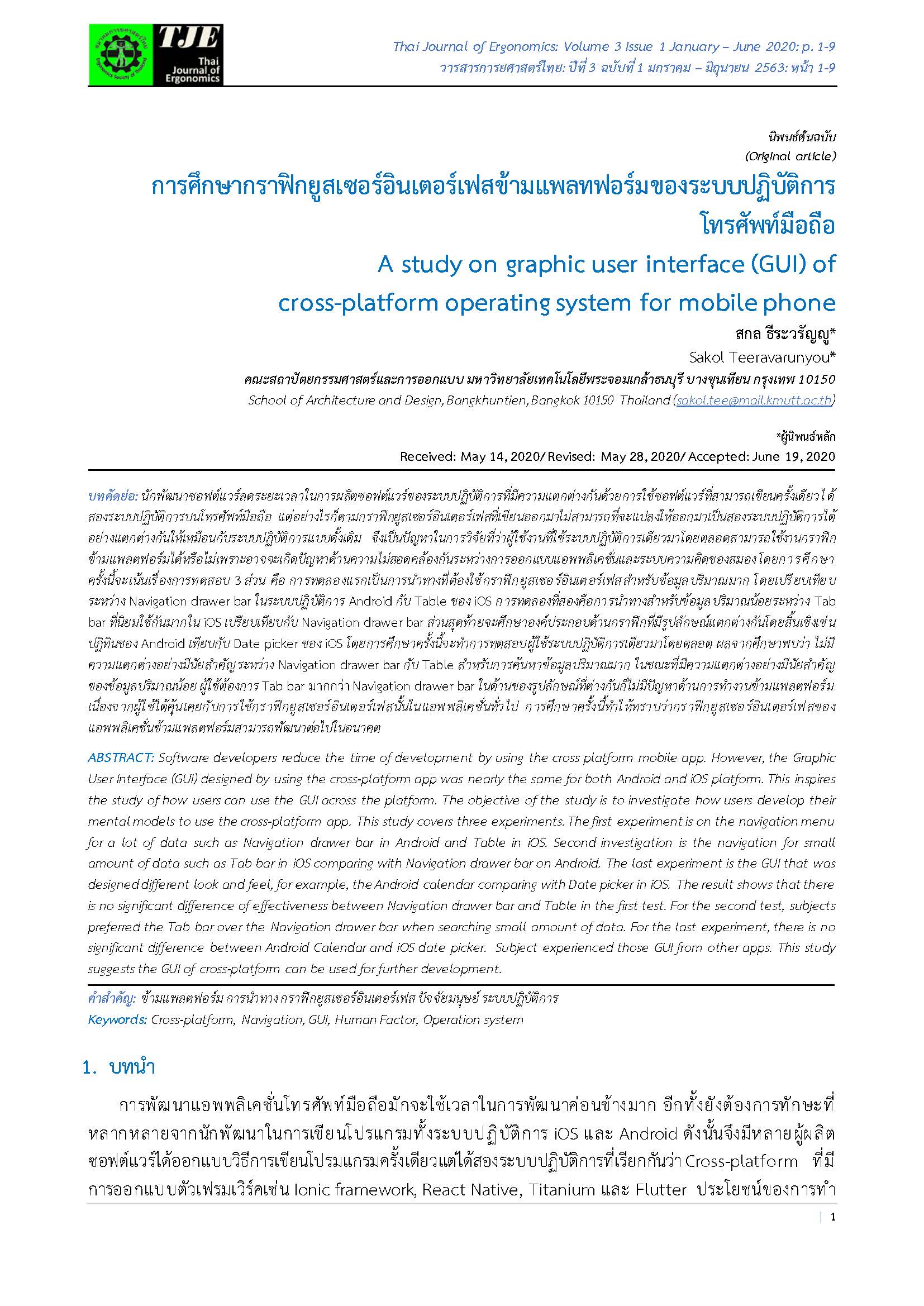A study on graphic user interface (GUI) of cross-platform operating system for mobile phone
Main Article Content
Abstract
Software developers reduce the time of development by using the cross platform mobile app. However, the Graphic User Interface (GUI) designed by using the cross-platform app was nearly the same for both Android and iOS platform. This inspires the study of how users can use the GUI across the platform. The objective of the study is to investigate how users develop their mental models to use the cross-platform app. This study covers three experiments. The first experiment is on the navigation menu for a lot of data such as Navigation drawer bar in Android and Table in iOS. Second investigation is the navigation for small amount of data such as Tab bar in iOS comparing with Navigation drawer bar on Android. The last experiment is the GUI that was designed different look and feel, for example, the Android calendar comparing with Date picker in iOS. The result shows that there is no significant difference of effectiveness between Navigation drawer bar and Table in the first test. For the second test, subjects preferred the Tab bar over the Navigation drawer bar when searching small amount of data. For the last experiment, there is no significant difference between Android Calendar and iOS date picker. Subject experienced those GUI from other apps. This study suggests the GUI of cross-platform can be used for further development.
Article Details

This work is licensed under a Creative Commons Attribution-NonCommercial-NoDerivatives 4.0 International License.
References
Manchada A. Where Do Cross-Platform App Frameworks Stand in 2020. [Cited on 11 May 2020]. Available from:
https://www.netsolutions.com/insights/cross-platform-app-frameworks-in-2019/
Denis C, Karsenty L. Inter-usability of multi-device systems: A conceptual framework. In: Amhmed S, Homa J, editors. Multiple user Interfaces. New York: Wiley; 2003. P. 373-384.
Majrashi K, Hamilton M, Uitdenbogerd AL. Correlating Cross-Platform Usability Problems with Eye Tracking Patterns. In: Proceedings of the 30th International BCS Human Computer Interaction Conference: Fusion! [Internet]. Swindon, GBR: BCS Learning & Development Ltd.; 2016. (HCI ’16). Available from: https://doi.org/10.14236/ewic/HCI2016.40
Mercado IT, Munaiah N, Meneely A. The Impact of Cross-Platform Development Approaches for Mobile Applications from the User’s Perspective. In: Proceedings of the International Workshop on App Market Analytics 43–49 (Association for Computing Machinery, 2016).
Angulo E, Ferre X. A Case Study on Cross-Platform Development Frameworks for Mobile Applications and UX. In: Proceedings of the XV International Conference on Human Computer Interaction [Internet]. New York, NY, USA: Association for Computing Machinery; 2014. Available from: https://doi.org/10.1145/2662253.2662280
Apple Inc. Human Interface Guidelines. [Cited on 11 May 2020]. Available from: https://developer.apple.com/design/human-interface-guidelines/
Google. Material. [Cited on 11 May 2020]. Available from: https://material.io
Nersession NJ. In: The Theoretician’s Laboratory: Thought Experimenting as Mental Modeling. PSA: Proceedings of the Biennial Meeting of the Philosophy of Science Association. 1992; 2:291-301
Friard O, Gamba M. BORIS: a free, versatile open-source event-logging software for video/audio coding and live observations. Methods in Ecology and Evolution 2016; Nov;7(11):1325-30
Pfaff B. PSPP Users' Guide. GNU PSPP Statistical Analysis Software. Release 0.8.5. Boston, MA: Free Software Foundation. 2015. Available from: http://www.gnu.org/software/pspp/documentation.html
Reason J. Human Error. Cambridge, UK: Cambridge University Press, 1990.
American National Standards Institute. Human Factors Design Process for Medical Devices, ANSI/AAMI HE74:2001.


